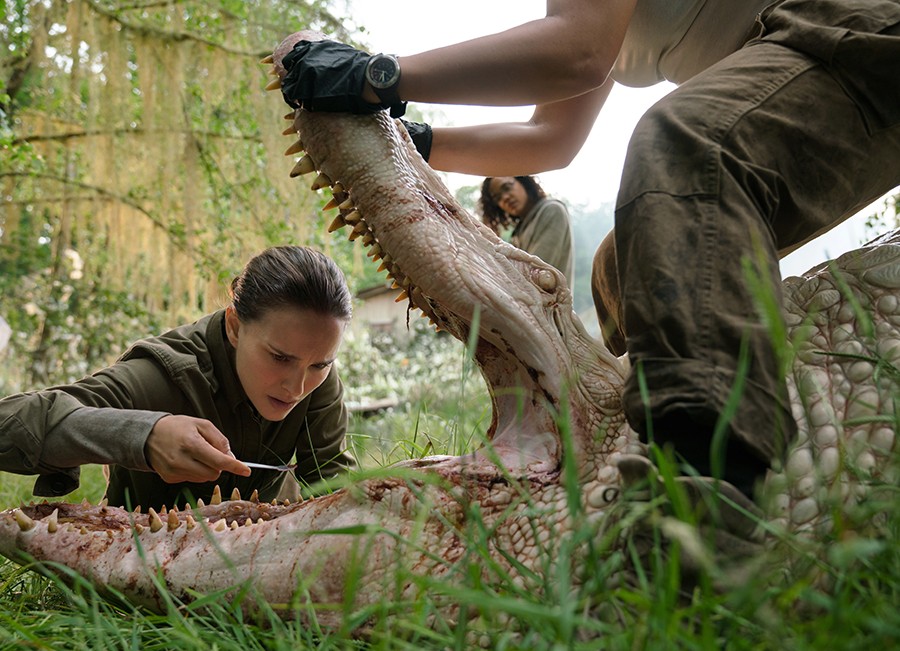Virginia Woolf had something to say about lighthouses. In her 1927 novel, To the Lighthouse, she addressed the object’s status as a beacon and guiding force. And just as Richard Burton and Elizabeth Taylor proved that there might be something to fear from Woolf, writer-director Alex Garland has shown, with his new sci-fi brainteaser Annihilation, that audiences should approach his creation with trepidation too, at least intellectually.
Natalie Portman stars as Lena, an ex-military biologist devastated by the presumed death of her soldier husband, Kane (Oscar Isaac). But when Kane stumbles home dazed and dehydrated, she realizes something is wrong with both him and the secret mission he has returned from, noting, “The silence around it is louder than normal.”
Lena soon seeks medical treatment for Kane but instead finds herself transported to Area X (where her husband escaped from) and interrogated by a strangely aloof psychologist (Jennifer Jason Leigh). Despite its X-Files vibe and obvious comparison to Area 51, it’s really just a science lab on the edge of an environmental disruption labeled the “shimmer,” somewhere on the U.S. Gulf Coast. A colorful CGI combination of the Northern Lights and a Steve McQueen horror film from 1958, it might just as easily be called the aurora blobealis. But despite this silly outer appearance, its inside holds vast mysteries, as Kane discovered after becoming the lone survivor of a previous expedition.
That failed mission was designed to reach the heart of the shimmer: a lighthouse, which is regarded as ground zero for a presumed alien intrusion. And though it stretches credibility, Lena becomes convinced that the only way to save her husband and discover the truth behind his illness is to reach that lighthouse, both literally and figuratively. And so, in a fashion not unlike a lesser film such as Predator — with which it shares some familiar genre tropes — Lena ventures forth with four other female scientific explorers, where no woman has gone before.
“And all the lives we ever lived and all the lives to be are full of trees and changing leaves,” Woolf wrote.
Revealing the connection between that quote and Lena’s discoveries would be inappropriate, suffice to say that the film challenges our notions of identity, perception and even life. (It’s not a coincidence that Lena specializes in genetics.) But Garland’s movie, though refreshingly perplexing and strange — especially in its final act — is never quite as smart as it thinks it is. If his last movie, Ex-Machina, fell just short of its brilliant potential, Annihilation could be accused of overshooting its mark by trying to please fans of sci-fi action/horror while channeling 2001: A Space Odyssey and Solaris. In this respect, Annihilation, which Garland loosely adapted from the 2014 novel by Jeff VanderMeer, is not so much a step up or down from his last project as a step sideways.
Portman and Isaac are effective despite their awkward chemistry. But maybe it’s that odd connection that helps drive the film’s quirky sensibility. After all, who are these two random individuals given the seemingly impossible and cinematically contrived task of exploring a potentially extra-terrestrial environment? While the characters and their backstories — which come in sandwiched flashbacks — are not wholly relatable, there is a certain profundity to their voyages of discovery.
The supporting actresses — all of whom are adequate but not especially memorable — portray uniquely flawed characters too, each one on her own personal journey. And it’s no accident that all five explorers are female. When interpreted realistically, it might seem ridiculous that five psychologically damaged individuals (of either gender) would be sent alone into a dangerous swamp with little support or means of escape. But, hey, the military guys had their chance, so why not send in the brainy women? And, admittedly, on a thematic level, their predicament is compelling.
Garland’s canvas is bigger than the one he used in Ex-Machina. Still, for the film’s first two-thirds, we see nothing particularly astonishing. Instead, Garland bides his time, employing deliberate pacing and interspersing some memorable and disturbing set pieces. It’s all a teaser for a finale that, despite some ridiculousness, rewards us with big ideas to ponder long after the projector flickers dark.
“There it was before her: life,” Woolf wrote. “Life: She thought, but she did not finish her thought.”
Garland is also loath to finish our thoughts. Instead, he lets us draw our own conclusions, guided by our own personal lighthouse.


